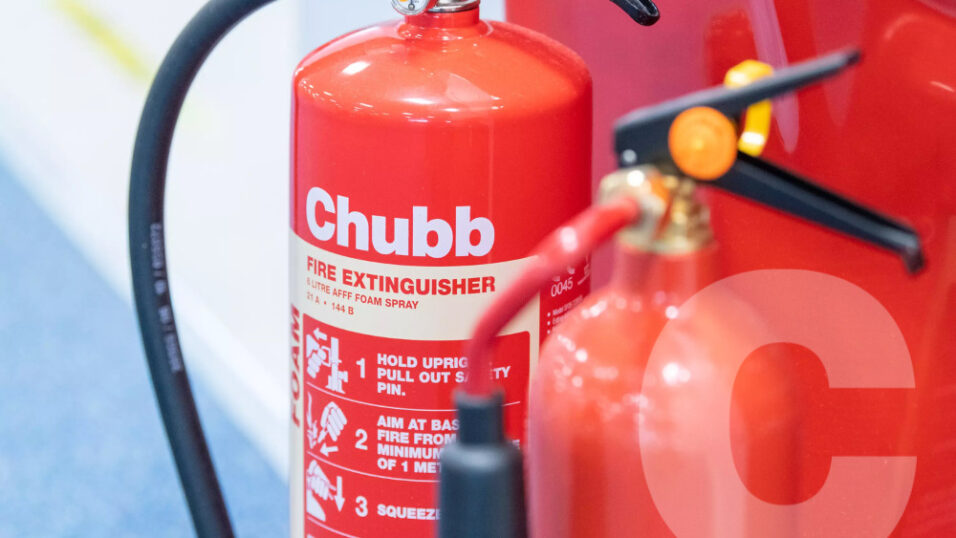



Changes to the extinguisher selection and positioning standard – using powder extinguishers indoors
By Chubb | 26th March 2024
On Thursday, November 30th, The British Standards Institution (BSI) unveiled revisions to their BS 5306-8:2023 code of practice. This updated code provides comprehensive guidance on fire safety measures, including the recommended quantity of fire extinguishers, criteria for selecting appropriate extinguisher types, and optimal placement strategies.
In our first blog, we discussed the use of water-based extinguishers on electrics. In this blog, we’ll be looking at the use of powder fire extinguishers indoors.
What does the British Standard say about powder?
Wide misinterpretation of one clause in the 2012 Standard led many to believe that powder could not be used indoors and, therefore, must be removed. With hindsight, dwelling on a single disadvantage of a single extinguishing agent was not representative, and that clause has since been removed. Instead, the new standard gives us pros and cons for all extinguishing agents.
The new standard asks that customers and extinguisher installers share information, so the right extinguishers are selected by matching fire-fighting needs with acceptable effects on people, property, and the environment. This makes sense, for example, if you protect your workplace with foam extinguishers you might wish to consider having a small powder extinguisher in the storeroom where valuable historic paper archives, oil or watercolour paintings are kept. But why, when powder would make a mess? A small fire in that room might damage one archive box, and the general mess that fire creates would need to be cleared up. But you would have that whatever extinguisher is used. The powder can easily be vacuumed along with the soot. Use of foam, however, might cause additional inks and pigments to run, rendering nearby artworks worthless or archives useless. That is just one example; the new Standard encourages you and your service provider to jointly make an educated judgement on which extinguisher is best – on balance.
Helpfully, the standard offers commentary to help us decide with advice on each agent:
- Water – Fights fire by wetting and cooling because of its high heat capacity. Therefore, it is a very effective medium for class A fires (involving combustible materials such as cloth, wood, paper etc) in jet, spray or mist form. However, water conducts electricity. Use of purified water (e.g. distilled, deionised or de‑mineralised) on fire causes it to revert to being conductive. Water can be corrosive and can cause soluble dyes (on paper) to run out. On the upside, water is kind to the environment.
- Water-based media, e.g. water-with-additive, foam and wet chemicals – these are chemical solutions in water, so class A fire capability is a given. The additives variously aid fire penetration, enhance wetting, and make bubble films or form crusts to deal with other classes of fire, which makes them important fire protection options. Of course, these conduct electricity in the same way as water does, so they should not be used on electrical equipment. They can cause metals to corrode, so nearby equipment will need to be cleaned. Some of these cannot be discharged to groundwater or surface drains, and some contain PFAS (per- and polyfluoroalklyl substances), which should now be incinerated.
- Powder – tackles fire very quickly, so much less agent is needed than others. Common ABC extinguisher powder is non-conductive, making it safe to use on electrics, but it can reduce visibility and might impair breathing, either of which could hinder escape – speedy and safe extinguishment trumps the latter in many experts’ opinion. Powder is also the most commonly used extinguisher due to it’s multi-purpose efficacy, and capability at low temperatures. Equipment and spaces contaminated with powder need to be vacuumed as soon as possible. If moistened, powder can be corrosive.
- Carbon dioxide (CO2) – is a white fog and in liquid form, expands into gas making it highly effective in penetrating electrical equipment which it does safely because it is non-conductive. Its discharge is louder than that of other extinguishers, but it does not need to be cleaned up. If discharged into a tiny unventilated space, it can be hazardous to health.
A final note on fires involving mains/bottled gas
The new Standard makes it clear that powder extinguishers should not be provided for gas hazards; better to extinguish the fire by turning off the gas or call the Fire & Rescue Service because leaking gas creates an explosion risk.
Many employers will have a powder extinguisher in a boiler house or similar and may be thinking they are of no use now. Don’t remove them. Be reminded that powder is not only the most commonly and successfully used extinguisher due it’s multi-purpose efficacy (class A, class B and non-conductive for electrics); it will also keep flowing at very low temperatures when water-based agents would have long-since frozen up.
Ultimately, it’s all about making the right choice. Fires need to be fought and certain fires can be equally tackled by a range of extinguishers. Help your extinguisher provider choose the right extinguisher for your workplace by sharing information.
How we can help
Our fire extinguishers have been protecting people and premises for over 200 years. We have the skills, knowledge and people to ensure your fire extinguishers are properly installed and serviced when required. We’re always up to date with the latest regulations and legislation, so you don’t have to be.
Contact one of our experts today – https://chubbfs.com/uk-en/products-solutions/fire/fire-extinguishers/
This blog is not an advertisement or advice document. It provides general information about a topic. You are responsible for complying with any legal or regulatory requirements that apply to you.
